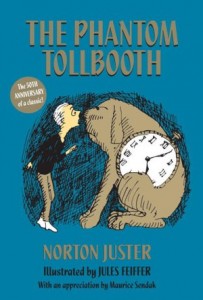 I remember loving The Phantom Tollbooth
I remember loving The Phantom Tollbooth as a child and I was pleasantly surprised by how well it held up. I read it out loud to my kids, which allowed me to explain some of the jokes and the overall metaphorical plot (why words and numbers require rhyme and reason to reach their full potential). However, with illustrations on nearly every page and so much visual wordplay, I think they’ll appreciate it on a whole new level when they read it again to themselves and experience the words on the page.
And I’m certain they will read it again. We had so much fun reading this, often laughing out loud together. It’s a very silly world in many ways, composed of puns and wordplay (one of my favorites is the island of Conclusions which people tend to jump to unintentionally. You have to swim through the Sea of Knowledge to get back on your way).
SPOILER ALERT: Things you might want to know before suggesting this to your kid
Not much, really. No sex or violence to speak of. Milo gets arrested and thrown in jail, but it turns out he can leave whenever he wants to. Things get a little tense at the very end, but not too bad—the humor counteracts any scariness. There’s a “save the world!” plot, but it’s a journey and a quest much more than it’s a battle and a race against time.
There are some pretty didactic lessons about the importance of education, the need to think about things, the existence of various points of view, and paying attention, but I didn’t mind too much since we’re always talking about that kind of thing anyway.
There are also lessons about the dangers of assuming that the things you love and are good at are more important than other things—there’s an ongoing feud between the king of Dictionopolis who thinks words are most important and his brother the Mathemagician of Digitopolis who is certain that nothing matters as much as numbers. This reflects conflicts I’ve seem among my own children, so it was good to have a way to discuss it that didn’t blame either of them for anything.
Recommendation
This is a good book for kids with an advanced vocabulary and a sense of puns, metaphor, and wordplay. However, reading it aloud makes it a great read for younger kids, too. Often all it took was for me to say a word meaningfully and they’d get the joke.
When we finished it, my son asked for another book with wordplay for our next read aloud. I was thrilled.
Kids update:
Both kids asked to read this book on their own after we finished reading it together—in fact, my son was so excited, he insisted that he be allowed to read it first. He talked about it at school and was thrilled when he learned that one of his friends also loves it.
My daughter read it as soon as my son finished it, and she mentioned that she was glad she got to read it on her own, because so much of the wordplay has a visual component to it. I think she liked it better when she read it on her own, but I wonder if she’d have gotten all the jokes if we hadn’t read it together first?
My personal version is now falling apart from age and so much reading. Luckily, there’s The Annotated Phantom Tollbooth which we picked up—it’s kind of heavy, though, so the kids are still read the falling apart one. I look forward to revisiting the story with the annotations, though!
Another update:
We now own a third copy of The Phantom Tollbooth. It’s been reread several times and my daughter chose Norton Juster as the author she would write a letter to, talking about how one of his books changed her life. I can’t recommend this book enough.
The Phantom Tollbooth by Norton Juster, illustrations by Jules Feiffer
Published in 1961 by Random House
Read my personal copy out loud to my kids





Speak Your Mind